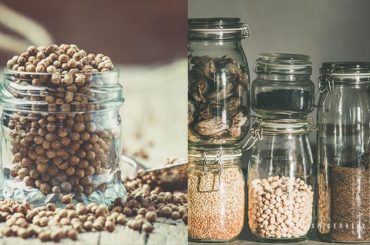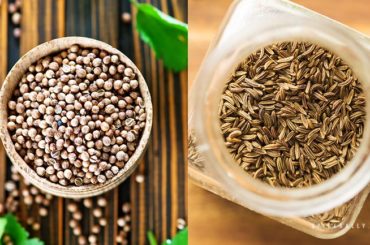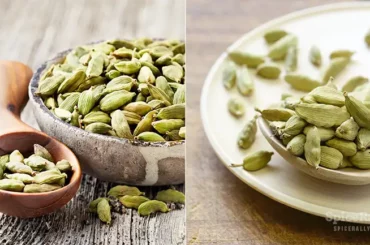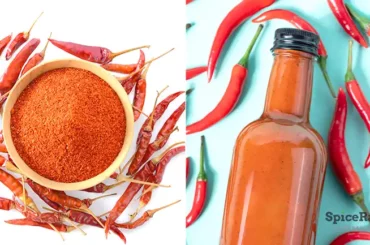Coriander and cumin are two spices that are popularly used together in many dishes. And also two main components in the great C’s of the world of spices- Coriander, Cumin, and Cardamom. But, despite being coupled well, coriander vs cumin has some differences in their contribution to flavoring dishes.
Coriander and cumin both are spices but with different flavor profiles, nutrition and appearance. However, they have this amazing pairing effect with food.
So, this article is dedicated to addressing the difference between coriander and cumin, including their flavor, aroma, availability, health benefits, and many more. If you ever hovered between these two spices when cooking, believe us, you won’t, after reading this!
Coriander Vs Cumin- Differentiating The Two Spices
We obviously don’t have to explain separately about the taste, aroma, and texture that coriander and cumin would add to a particular dish. They make such a good pair, especially when it comes to savory dishes.

However, as mentioned before, both of these spices have a few differences despite sharing some similarities. The taste and aroma they could add to the food could be pretty distinctive and distinguishable, even with different shapes.
So, on that note, we thought of sharing a table with you to explain the facts evidently about coriander vs cumin. Refer to the chart down below to learn everything that you weren’t familiar with about these two spices before.
| Coriander | Cumin | |
|---|---|---|
| Flavor Profile | Raw and dried seeds are floral, nutty, and warm. Flavor improves when dry-roasted. | A tempering spice with a warming, slightly bitter-sweet flavor with nutty and smokey aspects. Flavor enhances when dry-roasted or put to hot oil. |
| Fragrance Profile | Warm, nutty, floral, sweet with rose-like hints. | Warm, somewhat nutty, earthy, and pungent aroma. Aroma enhances when dry-roasted or put into the hot oil. |
| Forms used and availability | As whole seeds and in pulverized form. | As whole seeds and as in powdered form. |
| Dishes or food that pair well | – Dry meat rubs – Marinades – Spice blends – Seasonings – Apples – Beef – Chicken – Soup – Biscuits – Bread – Eggs – Ham – Lentils – Onions – Plums – Pork – Potatoes | – Dry spice rubs – Marinades – Seasonings – Spice blends – Rice dishes – Indian dishes – Curries – Chutneys – Semolina dishes – Sweet dishes – Candy – Stews – Stir-fries – Soups – Bread – Pickle – Biscuits – Barbecue sauces – Chili con carne – Vegetables – Chicken – Pork – Lamb – Beef – Mutton – Fish – Seafood |
| Culinary use | – As a spice – As a tea – A key component in many spice blends and seasonings | – As a spice – As a tea – A key element in many spice blends and seasonings. |
| Nutrition per 100g | 23 cal 0.52 g of fat 10.76g of protein 3.67g of carbohydrates | 375 cal 18g of protein 50g of fat 44g of carbohydrates |
| Health benefits | – Works as a stomach-soothing medicine – Alleviates upset stomach and flatulence – Reduces pain and swelling from arthritis and rheumatoid arthritis – Treats acidity, treats diarrhea, and chronic dysentery – Eases stomach pain caused due to indigestion – Improve digestion. – It supports lower and controls blood sugar – It potentially helps to treat several skin conditions – Decreases LDL cholesterol levels and boosts cardiovascular health. – It helps to fight against Salmonella. – Advantageous for eye health. – Provides protection against neurodegenerative diseases. | – Rich in antioxidants – Treats diarrhea – Contains anti-cancer properties – May fight against bacterial infections and parasites – It contains antiseptic properties that protect the immunity system. – Helps in controlling blood sugar – Has hypolipidemic substance that helps to lower harmful cholesterol levels in the body. – Rich in anti-inflammatory effects. – Treats and eases the symptoms of Irritable Bowel Syndrome (IBS) – Encourages weight loss – Stimulates the central nervous system, boosts memory and cognitive function. |
| Availability | Readily available as whole seeds or powder at leading supermarkets, local grocers, or online sellers. | Easily accessible as whole seeds or in the ground form at leading supermarkets, grocery stores, or online stores. |
| Price | – A 7-ounce whole seed packet will cost around $3.30 – A 14-ounce packet of coriander powder will cost about $2 | – A 0.95-ounce container of whole cumin seeds may cost around $2.96 – A 1.5-ounce container of ground cumin may cost about $3.14 |
| Shelf life | If stored correctly in containers with tight-fitting lids, whole coriander seeds could stay fresh for up to 3-4 years. And ground coriander, when stored in containers with tight-fitting lids, will stay fresh for up to 2-3 years. | Both whole cumin seeds and ground cumin can stay fresh for up to 3-4 years when properly stored inside air-tight containers. |
| Main featuring cuisines | Asian, North African, European, Middle Eastern | It is a staple in Latin American, Indian, North American, Cuban, Mexican, and Middle Eastern cuisines. |
| Appearance | Round, brown, tiny, light-weighted. | Yellow-brown in color and has an elliptical, longitudinally ridged shape that often resembles fennel and caraway seeds. |
| Harvesting | Coriander fruits are usually set around 120 days from the day the plant is grown. Then when the coriander fruit eventually turns brown, they are ready to harvest. | The cumin pods should be left in the cumin plant to ripen and turn brown. Then, the seeds should be removed from the plant and let dry. Pods are being rubbed to remove the seeds, and the whole stem can be trimmed and hung upside down in a bag to gather the seeds. |
| Scientific name | Coriandrum sativum | Cuminum cyminum |
| Plant Family | Apiaceae | Apiaceae |
| Other names | Leaves and stalks are called cilantro. | Popularly known as “Jeera” in Indian cuisine. |
| Origin | Origin not specified. | Originated from Southwestern Asia, Eastern Mediterranean, or Central Asia. |
| Coriander | Cumin |
What Is Coriander?
Coriander comes from the Coriandrum sativum plant. The seeds of this plant are regarded a spice, while the leaves and stalked are regarded as a herb.
It is a staple in many kitchens around the world that gives a lot of flavor and aroma to the food it is added to. In the USA, the leaves and plants of this plant are referred to as cilantro, while the seeds are known as coriander seeds. At the same time, the countries apart from the USA call the seeds coriander seeds and the leaves and stalks coriander itself. And also, it is famous as “Jeera” among the Indian cuisine.
Coriander Seeds are used as whole and ground. You can also buy the coriander leaves in their dried form or often as fresh.
What Is Cumin?
Cumin seeds come from the Cuminum cyminum plant and belong to the same plant family of coriander. It is also a spice that is packed with flavor and aroma with its remarkable health properties. Since ancient days, it has been used as a folk medicine that treats many health issues.
Unlike coriander, only the seeds of the cumin plant are used in culinary use. Cumin seeds are often confused with fennel seeds and caraway seeds that are completely different from this spice. But interestingly, all these spices- cumin, caraway seeds, and fennel seeds can be used as a substitute for coriander.
In addition to the culinary and medicinal use, the essential oil of cumin seeds is employed in different industries. Cumin essential oil is beneficial in flavoring liquors, perfume making, and multiple sweets like toffees, lollies, and chocolates.
Can You Substitute These Spices With Each Other?
These two spices actually share a good family bond, coming from the same plant family. But, although they are from the same Apiaceae plant family, they have different flavor and scent profiles.
Above all, thanks to the family bond they share, cumin is among the top alternatives that you could use in place of coriander. But, we remind you again that they aren’t sharing the exact flavors.
But still, cumin can be substituted in place of coriander. Moreover, ground coriander can also be used in place of cumin seeds. However, the combination they make together is a whole different story!
Flavorings like caraway seeds and fennel seeds can be considered as other common spices that could be used as substitutes for both of these spices.
Need to learn about more substitutes for coriander? Click here for a complete guide of 9 coriander seeds and coriander leaves substitutes.
Coriander Vs Cumin – Usage In Cooking
Well, when it comes to cooking with these two spices, we could count on more similarities than differences. This is mainly because that they could be used together in many savory dishes. And also, they could be substituted for each other.
In fact, the flavor combination they make together is simply unparalleled and, of course, very nutritious. Coriander pairs well with spices like cumin, caraway seeds, fennel seeds, ginger, allspice, chili, cinnamon, garlic.
And, at the same time, cumin seeds make perfect flavor blends with cardamom, cinnamon, cloves, coriander, curry leaves, fennel seeds, garlic, ginger, nutmeg, oregano, paprika, thyme, and turmeric.
Once you get a spice in your home, you have it forever. Women never throw out spices. The Egyptians were buried with their spices. I know which one I’m taking with me when I go
Erma Bombeck, The American Journalist
If you go for cumin substitution with coriander, you will probably have to go for ground coriander, as we discussed earlier. And, both of these spices sit well with savory dishes, soups, stews, meat dishes, and stir-fries.
In addition, we can see that cumin is an integral part of many Indian and Sri Lankan sweetmeats. They use either whole dry-roasted cumin seeds or ground cumin with many sweet dishes, while coriander is used only with a limited amount of sweet treats.
This duo also takes a significant place in Ayurvedic medicines for their remarkable soothing, healing, cooling, and detoxifying properties. Therefore, both of these spices can be considered as a match made in heaven!
Coriander Vs Cumin- More Similarities Than Differences
The intention of this article was to bring you all the similarities and differences that you should learn about coriander vs cumin. And as you see, both of these spices count for more resemblances than differences.
In fact, coriander and cumin both belong to the same plant family, although they are different in flavor, aroma, shape, and nutrition.
Their family bond makes it a reason for them to make a perfect pair when combined together to be included in most recipes.
Pro Tip: So, if you have both of these spices in your spice rack right now, just take equal amounts from each container- maybe like two tablespoons. Dry-roast them in a pan and then grind them together. Now, use this blend with your favorite meat as a marinade or a dry rub!




